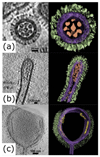Filamentous influenza viruses
- PMID: 27365089
- PMCID: PMC5935222
- DOI: 10.1099/jgv.0.000535
Filamentous influenza viruses
Abstract
Clinical isolates of influenza virus produce pleomorphic virus particles, including extremely long filamentous virions. In contrast, strains of influenza that have adapted to laboratory growth typically produce only spherical virions. As a result, the filamentous phenotype has been overlooked in most influenza virus research. Recent advances in imaging and improved animal models have highlighted the distinct structure and functional relevance of filamentous virions. In this review we summarize what is currently known about these strikingly elongated virus particles and discuss their possible roles in clinical infections.
Figures



Similar articles
-
Characterization of the host cell entry of filamentous influenza virus.Arch Virol. 2005 Sep;150(9):1783-96. doi: 10.1007/s00705-005-0558-1. Epub 2005 Jun 15. Arch Virol. 2005. PMID: 15959836
-
Single-particle measurements of filamentous influenza virions reveal damage induced by freezing.J Gen Virol. 2019 Dec;100(12):1631-1640. doi: 10.1099/jgv.0.001330. J Gen Virol. 2019. PMID: 31553305 Free PMC article.
-
Structural Analysis of the Roles of Influenza A Virus Membrane-Associated Proteins in Assembly and Morphology.J Virol. 2015 Sep;89(17):8957-66. doi: 10.1128/JVI.00592-15. Epub 2015 Jun 17. J Virol. 2015. PMID: 26085153 Free PMC article.
-
Influenza virus morphogenesis and budding.Virus Res. 2009 Aug;143(2):147-61. doi: 10.1016/j.virusres.2009.05.010. Epub 2009 May 27. Virus Res. 2009. PMID: 19481124 Free PMC article. Review.
-
Assembly and budding of influenza virus.Virus Res. 2004 Dec;106(2):147-65. doi: 10.1016/j.virusres.2004.08.012. Virus Res. 2004. PMID: 15567494 Free PMC article. Review.
Cited by
-
The shape of pleomorphic virions determines resistance to cell-entry pressure.Nat Microbiol. 2021 May;6(5):617-629. doi: 10.1038/s41564-021-00877-0. Epub 2021 Mar 18. Nat Microbiol. 2021. PMID: 33737748
-
Influenza A Virus Hemagglutinin-Neuraminidase-Receptor Balance: Preserving Virus Motility.Trends Microbiol. 2020 Jan;28(1):57-67. doi: 10.1016/j.tim.2019.08.010. Epub 2019 Oct 17. Trends Microbiol. 2020. PMID: 31629602 Free PMC article. Review.
-
The feather epithelium contributes to the dissemination and ecology of clade 2.3.4.4b H5 high pathogenicity avian influenza viruses in ducks.Emerg Microbes Infect. 2023 Dec;12(2):2272644. doi: 10.1080/22221751.2023.2272644. Epub 2023 Nov 3. Emerg Microbes Infect. 2023. PMID: 37847060 Free PMC article.
-
Influenza as a molecular walker.Chem Sci. 2019 Nov 14;11(1):27-36. doi: 10.1039/c9sc05149j. eCollection 2020 Jan 7. Chem Sci. 2019. PMID: 32153750 Free PMC article. Review.
-
Multiplexed Biosensing of Proteins and Virions with Disposable Plasmonic Assays.ACS Sens. 2023 Sep 22;8(9):3338-3348. doi: 10.1021/acssensors.2c02238. Epub 2023 Aug 23. ACS Sens. 2023. PMID: 37610841 Free PMC article.
References
-
- Ada GL, Perry BT. Properties of the nucleic acid of the Ryan strain of filamentous influenza virus. Journal of general microbiology. 1958;19:40–54. - PubMed
-
- Ada GL, Perry BT, Abbot A. Biological and physical properties of the Ryan strain of filamentous influenza virus. J Gen Microbiol. 1958;19:23–39. - PubMed
-
- Ada GL, Perry BT, Edney M. Infectivity of influenza virus filaments. Nature. 1957;180:1134. - PubMed
-
- Al-Mubarak F, Daly J, Christie D, Fountain D, Dunham SP. Identification of morphological differences between avian influenza A viruses grown in chicken and duck cells. Virus research. 2015 - PubMed
Publication types
MeSH terms
Grants and funding
LinkOut - more resources
Full Text Sources
Other Literature Sources
Research Materials

